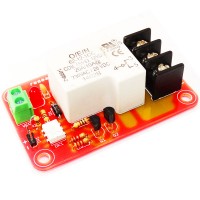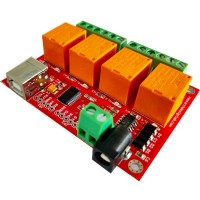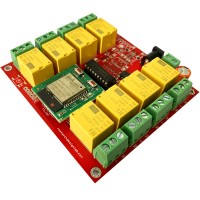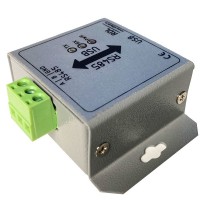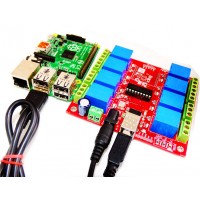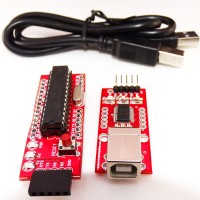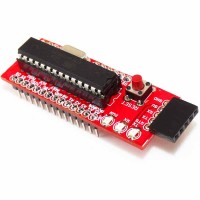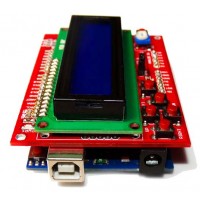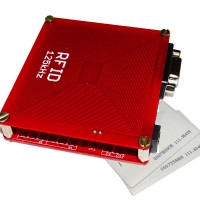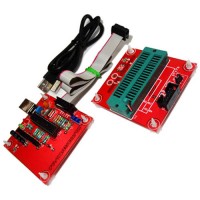Search results for 'ht 12'
-
The board has only one relay driven by TTL circuit and MCT2E IC for isolation purpose.The board works on 12V but the input signal can come directly from microcontroller output working at 5V to control relays. Relay can switch varierty of AC or DC high voltage, high current 20A,loads working at 110V or 230V AC mains like lights, fans, motors and such. The status of relay is indicated by individual LEDs.
Order Code : RDL/SRB/14/001/V3.0
Learn More -
This relay board with 4 SPDT relays and digital IO controlled via USB protocol, Suitable for home automation applications, hobby projects, and industrial automation. The free software application allows controlling relays manually or automatic operation by creating timers for each channel and enabling repeat cycle. Relay module support Windows & Linux platform, .Net / JAVA / Python SDK available for developing custom application.
Order Code: RDL/4RB/14/001/V4.0
Learn More -
This is Eight Channel relay board controlled by Bluetooth Module. The Bluetooth relay board is with 8 SPDT relays rated up to 7A each. You can control devices 230V / 120V (up to 8) directly with one such relay unit. Suitable for home automation applications, hobby projects, industrial automation. Bluetooth module enables you to wireless transmit & receive serial data.
Order Code : RDL/8RB/14/001/V1.0
Learn More -
Learn More
The USB to RS485 is a fully automatic plug-and-play USB module that connects to your PC via the Universal Serial Bus (USB) port and provides robust bidirectional USB to RS-485 protocol conversion with automatic RS-485 flow control.
Order Code: RDL/RSU/14/001/V1.0
-
USB 8 Channel Relay Board FT245RL is controlled by computer USB port. The USB Relay Board is with 8 SPDT relays rated up to 7A each. You may control devices 230V / 120V (up to 8) directly with one such relay unit. Suitable for home automation applications, hobby projects, industrial automation.
Order Code : RDL/8RB/14/001/V2.0
Learn More -
Atmega 328 is one of the most commonly used Micro controllers with open source platform amongst many hobbyist and industrial communities. The simplicity and the low power of Atmega 328 helps design many prototype boards which could be used in numerous applications.
ORDER CODE: RDL/DUF/14/001/V1.0
Learn More -
Atmega 328 is one of the most commonly used Micro controllers with open source platform amongst many hobbyist and industrial communities. The simplicity and the low power of Atmega 328 helps design many prototype boards which could be used in numerous applications.
ORDER CODE: RDL/A38/14/001/V1.0
Learn More -
One of the basic interfacing requirements for the hobbyists or electronics enthusiasts is I/P (keypad) and O/P (LCD display) for proyotype applications. This shield uses minimum number I/O’s that is 2 bits(D0 and D1) for LCD data . 5 input key switches (Navigation keys), when it's activated serial data will be sent to pin D0 by internal 2 line LCD controller. Each key has been pulled up to a different voltage level, so a different voltage will be generated every time a user selects a key. This voltage could be read by the analog pin of internal 2 line LCD controller on the board. Hence saves the no of I/O pins. The backlight of the LCD could be controlled by setting PWM (Pin D10) by adding a few lines of code.
Order Code : RDL/LKS/14/001/V1.0
Learn More -
Low Frequency 125kHz RFID Reader with USB/Serial interface with range 0-5 CM. Board level RFID readers can easily integrated with custom build application / solution via serial communication. Interfacing Wi-Fi module with this serial RFID reader can connect IoT application software, for monitoring and identification.
Order Code : RDL/RRS/14/001/V1.0
Learn More -
The PICkit™ 2 Development Programmer/Debugger is a low-cost development tool with an easy to use interface for programming and debugging Microchip’s Flash families of microcontrollers
Order Code : RDL/PUZ/14/001/V1.0
Learn More


